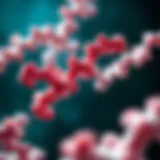Effective Household Water Purification Methods


Intro
Access to clean drinking water is a fundamental necessity that often goes overlooked until it becomes a pressing issue. In the modern world, where pollution and chemical runoff threaten the purity of natural water sources, understanding household purification methods becomes increasingly vital. This approach not only addresses health concerns but also encourages sustainable practices that can benefit the entire community.
Households today have a plethora of options at their disposal, ranging from time-honored techniques passed down through generations to cutting-edge technologies that promise efficiency and effectiveness. Empowering ourselves with knowledge about these methods can lead us towards healthier lives and a more sustainable future. In this article, we will explore the range of methods for purifying household water, highlighting their pros and cons to help families make informed choices.
Recent Advances
With ongoing research and innovation in the field of water purification, new methods and technologies have emerged, drastically changing the game for households around the globe.
Latest Discoveries
Recent studies have uncovered various ways to enhance the traditional purification processes. For instance, the use of activated charcoal has gained renewed interest, showing impressive results in removing contaminants and improving taste. Researchers have found that combining this with basic filtration systems can lead to significant improvements in water quality.
Technological Innovations
Advancements in materials science have led to the development of more efficient filtration membranes. These membranes can remove even the smallest impurities, bacteria, and viruses, ensuring that the water is not just clear but safe to drink. Among these innovations, nano-filtration and reverse osmosis units have become household staples, providing a high level of purification in a compact format.
"The integration of technology in water purification has not only improved accessibility but also made it cost-effective for many communities."
Methodology
Understanding how these methods work requires a closer look at their underlying principles and practical applications. The approach here includes analyzing traditional practices alongside modern technologies to compare efficacy and operational nuances.
Research Design
This examination entails qualitative assessments of various purification methods. By analyzing case studies and user feedback, we can gauge the efficiency of each technique in real-world applications, identifying their strengths and limitations.
Data Collection Techniques
Data will be collected from diverse sources such as community workshops, academic research papers, and feedback from users of different purification systems. This multifaceted approach offers a comprehensive view of household water purification, ensuring that insights drawn are relevant and actionable.
By collaborating with communities and collecting diverse data points, the findings will reflect a broad spectrum of experiences and methodologies, empowering readers with practical knowledge.
Intro to Household Water Purification
Water is an essential element for life, and its purity can significantly impact our health and well-being. Understanding how to effectively purify household water is critical, not only for sustaining our daily lives but also for ensuring the safety of our families. In this section, we will dive deep into the importance of water purification methods, their implications, and how they can positively influence our quality of life.
Importance of Water Purification
Water purification is more than a mere convenience; it serves as a strong line of defense against illness. Contaminated water can harbor harmful microorganisms and toxic substances that pose serious health risks. According to the World Health Organization, around 2 billion people globally drink contaminated water.
When you purify your water, you are investing in your health and that of your loved ones. Here are critical reasons why understanding and practicing water purification at home is essential:
- Health Protection: Ensures removal of pathogens and harmful chemicals, reducing risks of waterborne diseases.
- Taste and Odor Improvement: Purification can significantly enhance the taste and smell of water, making it more enjoyable to drink.
- Better Cooking and Drinking: When cooking or making beverages, the use of purified water can elevate flavors and ensure food safety.
- Saving Money: Investing in purification technology can limit the need for bottled water, cutting down on expenses over time.
- Environmental Responsibility: Utilizing home purification methods often leads to reducing plastic waste, promoting a more sustainable lifestyle.
The benefits go beyond individual households. Every clean glass of water contributes to community efforts aimed at reducing contamination levels in local water sources.
Global Water Quality Concerns
Around the world, access to clean water is not guaranteed. Water quality concerns vary based on geographical, political, and economic factors, leading to a diverse range of issues:
- Diminishing Freshwater Resources: Many areas are experiencing a significant decrease in available freshwater due to pollution and overuse.
- Industrial Waste Impact: Factories and industrial plants often discharge toxic waste into rivers, lakes, and groundwater, leading to heightened levels of pollution.
- Climate Change Effects: Shifts in weather patterns can cause floods and droughts, further affecting water supplies and quality.
At a global scale, the lack of clean water access can lead to conflicts and migration, highlighting the pressing need for effective purification solutions at home and abroad.
"Water is the source of life, and ensuring its purity is vital for health and survival, making the subject of water purification an urgent global agenda."
As awareness spreads about these issues, more households are looking for solutions. The actions taken at the individual level can pave the way for collective progress towards better water quality. Addressing these concerns through household water purification methods is a small yet vital step toward a bigger solution.
In summary, understanding the necessity of household water purification not only supports personal health but also contributes to larger conversations about sustainability, safety, and global water equality. This section sets the groundwork for exploring various methods that can help ensure safe drinking water for everyone.
Understanding Contaminants in Household Water
Understanding the various contaminants present in household water is foundational for ensuring the safety and quality of the water we consume daily. As water travels and interacts with different environments, it often picks up substances that can pose health risks or affect taste and clarity. Knowledge about these contaminants arms homeowners with the power to make informed decisions regarding water purification methods. Identifying the type and source of contaminants can guide us in selecting the right purification technology tailored to our specific needs.
Types of Contaminants
Microorganisms
Microorganisms are minuscule organisms that can exist in water. They include bacteria, viruses, and protozoa. These organisms are contributors to a wide array of waterborne diseases. A key characteristic of microorganisms is their ability to reproduce rapidly, making them particularly dangerous. For instance, a single E. coli bacterium can multiply to thousands in just a few hours. This makes addressing microbial contamination a priority for households that rely on well water or untreated sources.
A unique feature of microorganisms is their variability; while certain bacteria are harmless, others can lead to severe gastrointestinal issues. Filters designed to target microorganisms, such as UV purification systems, are highly effective in eradicating them, ensuring a safe supply of water. However, some methods may not effectively remove all types of microorganisms, which can potentially pose a risk if not properly assessed.
Chemical Pollutants
Chemical pollutants comprise a diverse range of substances, including pesticides, fertilizers, and industrial chemicals. The presence of these chemicals in water can cause serious health problems, like hormonal disruptions and several forms of cancer. Their volatile nature means they can enter water systems through runoff, making this a common issue, especially in urban settings.
Chemical pollutants have a distinctive characteristic—they can be both visible and invisible. For example, heavy metals may cause discoloration, while pesticides might not impart any visible changes, yet can profoundly affect health. Therefore, deploying advanced filtration systems, such as reverse osmosis, can effectively reduce these contaminants but often requires regular maintenance and be financially demanding in the long run.
Heavy Metals


Heavy metals such as lead, mercury, and arsenic can leach into household water supplies from old plumbing, industrial waste, or even geological formations. One of their distinctive characteristics is that they bioaccumulate, meaning they can build up over time in the body, leading to chronic health issues. The presence of these metals in water is especially concerning given their long-lasting effects.
For households, the main advantage of identifying heavy metals in water is the trigger for action—a reason to implement specific water treatment solutions. Technologies like activated carbon filters or specialized heavy metal removal systems can effectively reduce these toxins. Yet, while effective, these methods can also be cost-prohibitive for some homeowners.
Sources of Water Contamination
Agricultural Runoff
Agricultural runoff is a significant contributor to water contamination, especially in rural areas. It often carries fertilizers, pesticides, and herbicides into nearby water bodies. The characteristic feature of agricultural runoff is its seasonal influence; during heavy rains, contaminants can wash directly into rivers and lakes. This shows how farming practices dramatically influence local water quality.
One primary advantage of understanding agricultural runoff lies in the ability to advocate for improved farming practices. Encouraging sustainable agriculture and proper waste-management techniques can substantially reduce this type of contamination. However, addressing it can be challenging, as it requires cooperation from various stakeholders, including local farmers.
Industrial Discharge
Industrial discharge refers to the release of waste from manufacturing processes into waterways. This can include toxic chemicals and heavy metals, often coming from factories situated near water sources. A critical characteristic of industrial discharge is the potential for large-scale contamination events. One plant discharging pollutants can affect a vast area downstream.
Monitoring industrial discharge can lead to regulatory changes aimed at improving water safety. While there are strict laws in many regions, enforcing these can be tricky. Resistance from industries focused on profits may slow down necessary adaptations to cleaner practices.
Household Waste
Household waste, often a lesser-discussed pollutant, includes everything from detergents to personal care products. The key aspect of household waste is its pervasive presence in daily living. In an urban environment, improper disposal can lead to significant contamination of local water supplies.
One advantage of understanding the impact of household waste is the empowerment it provides homeowners to adopt better practices. For instance, opting for biodegradable products can significantly reduce the chemicals entering water systems. However, many consumers remain unaware of the cumulative effects of their waste disposal habits, hindering progress in tackling this issue.
"Recognizing the types and sources of contaminants is not merely academic; it is an urgent call to action at the household level."
By grasping the scope and nature of contaminants in household water, homeowners can make well-informed choices as they explore purification methods tailored to their water quality problems.
Traditional Methods of Water Purification
Water is a fundamental necessity for life, and the methods by which it is purified at home can significantly affect family health. This section covers traditional purification methods, which remain relevant due to their effectiveness, simplicity, and accessibility. While modern techniques have emerged, understanding these time-tested methods serves not only as a back-to-basics approach but also as a means of ensuring safe drinking water when advanced systems are either unavailable or too costly.
Boiling
Boiling water is perhaps the simplest and one of the most effective methods to kill pathogens. By bringing water to a rolling boil for at least one minute, harmful microorganisms like bacteria, viruses, and protozoa are eradicated. This method is particularly vital in regions with unreliable water sources or where contamination risk is high.
Benefits of Boiling:
- Affordability: It requires no special equipment—just a pot and a heat source.
- Effectiveness: Boiling is proven to kill most pathogens.
- Simplicity: Very straightforward; anyone can do it.
However, boiling does not remove chemical pollutants or heavy metals. Therefore, while this method serves as a frontline defense against biological contaminants, it shouldn’t be the sole method used for water purification.
Filtration with Cloth
Using cloth for filtration is a practice as old as civilization itself. By pouring water through a clean cloth, larger particles, such as dirt and debris are removed. This method can be used in combination with others, for example, after sedimentation or prior to boiling, to enhance overall water quality.
Benefits of Cloth Filtration:
- Accessible: Most households have some form of cloth available, such as a clean kitchen towel or a bandana.
- Preliminary Step: Useful as an initial step before employing more extensive purification methods.
It's important to regularly wash the cloth to maintain its effectiveness; a dirty filtration medium could introduce more contaminants. In addition, this method can't handle microorganisms effectively, so it should be part of a multi-tiered purification approach.
Sedimentation
Sedimentation is the process of allowing particles to settle out of water. By placing water in a container and letting it sit undisturbed for several hours, heavier particles will naturally sink to the bottom, leaving clearer water at the top. This method is practical in areas where immediate purification is unnecessary and can work in tandem with boiling or filtration.
Benefits of Sedimentation:
- Cost-Effective: Requires no purchase of materials or equipment.
- Energy Efficiency: It doesn't require heat or electricity, making it ideal in distant or off-grid locations.
While sedimentation can reduce turbidity and some contaminants, it will not eliminate microorganisms on its own. For safest results, use sedimentation followed by boiling or filtration.
In summary, the traditional methods of water purification offer valuable, accessible options for households aiming to ensure safe drinking water. They are especially important in regions where modern technology is not accessible, providing basic safeguards against contamination.
Modern Purification Technologies
In the quest for clean and safe drinking water, modern purification technologies play a pivotal role. They are crucial not only due to their efficiency but also because they address the increasingly complex challenges posed by different contaminants in our water supply. As traditional methods often fall short in effectiveness, turning to these cutting-edge techniques offers homes a refuge from impurities. This section unfolds the fascinating world of water purification, uncovering the features and perks of its latest technologies.
Activated Carbon Filters
Activated carbon filters leverage a well-known physical principle: adsorption. Here, contaminants in the water cling to the surface of the activated carbon material when water passes through it. This is akin to how a sponge absorbs water, yet much more refined.
Benefits of Activated Carbon Filters:
- Effective in Removing Chlorine: They significantly reduce chlorine taste and odor from tap water, making it more palatable.
- Removes Volatile Organic Compounds (VOCs): These filters can catch various organic chemicals that may disrupt health, like benzene and formaldehyde.
- Affordable and Maintenance-Friendly: Their installation is often straightforward, and replacing carbon is usually quite hassle-free.
However, it is pivotal to remember that, while these filters can enhance taste and address some pollutants, they may not fully eliminate heavy metals or pathogens. Hence, it's often recommended to use them in tandem with other purification methods for a more comprehensive solution.
Reverse Osmosis Systems
Reverse osmosis (RO) systems have gained popularity for their ability to cleanse water on a molecular level. Using a semi-permeable membrane, these systems push water through at high pressure, effectively rejecting contaminants while allowing pure water to pass.
Key Features of Reverse Osmosis:


- Wide Range of Contaminant Removal: They can tackle everything from heavy metals to bacteria and nitrates, making RO systems one of the most thorough purification methods available.
- Enhanced Taste and Clarity: In addition to removing harmful substances, RO systems improve the overall taste and clarity of drinking water.
- Increased Safety: By ensuring that harmful pathogens and pollutants are effectively filtered out, RO systems provide peace of mind.
Despite their numerous benefits, users should be aware that RO systems typically generate wastewater during the process, which might pose environmental concerns. Additionally, they often require some maintenance, including changing filters and membrane replacements on a routine basis.
Ultraviolet Purification
Ultraviolet (UV) purification is another modern marvel. Utilizing light at a specific wavelength, UV purification systems effectively neutralize microorganisms without the addition of chemicals.
Advantages of Ultraviolet Purification:
- Does Not Alter Water's Chemical Composition: Since it only uses light, this method does not introduce substances that could interfere with water's natural state.
- Rapid Action Against Pathogens: UV light swiftly inactivates bacteria, viruses, and protozoa, providing a robust defense against waterborne pathogens.
- Low Maintenance Requirements: Aside from periodic lamp replacement, UV systems generally require minimal upkeep.
On the flip side, UV purification only works if the water is clear. Turbidity can impair the effectiveness of the light, so having a pre-filtration stage often becomes necessary. Also, it's essential to understand that while UV can neutralize pathogens, it doesn't remove chemical contaminants or sediments.
"Modern purification technologies, like activated carbon filters, reverse osmosis systems, and ultraviolet purification, each bring unique benefits but are most effective when used in combination, tailored to your specific water quality challenges."
In summary, these modern technologies are essential allies in the battle for clean drinking water. By understanding their strengths and limitations, households can make informed decisions that ensure better health outcomes and ultimately contribute to a more sustainable future.
Comparative Effectiveness of Water Purification Methods
In understanding household water purification, it becomes essential to grasp how different methods stack up against each other. Lives can depend on the choice we make, whether it’s about eliminating harmful pathogens or keeping chemical residues at bay. Evaluating the comparative effectiveness of these techniques not only helps in making informed decisions but also enhances the overall quality of drinking water. The right method can protect family health and promote sustainability, ensuring that our water remains clean for those who rely on it.
Effectiveness Against Microorganisms
When it comes to microorganisms, the stakes are pretty high. Pathogens like bacteria, viruses, and parasites can lurk in untreated water, causing serious health problems. Methods like boiling, reverse osmosis, and ultraviolet (UV) purification prove very effective against these threats.
Boiling water is one of the oldest tricks in the book, reliably killing off those vicious critters. A rolling boil for a minute typically does the trick.
On another hand, UV purification systems utilize light to zap microorganisms, making them an excellent choice for households. While they’re highly effective, the water clarity is crucial; turbid water can hinder the effectiveness.
- Key Techniques:
- Boiling: Good for all microbes; no special equipment needed.
- Reverse Osmosis: Removes bacteria but requires maintenance and regular checks on filters.
- Ultraviolet Purification: Fast and effective, but needs clean water for best results.
Understanding these nuances can guide users toward safer drinking water, as not all systems tackle pathogens equally well.
Chemical Contaminants Removal
In the realm of water purification, chemical contaminants pose a significant risk. Different methods are better equipped to handle these pollutants. For instance, activated carbon filters are renowned for removing chlorine, pesticides, and volatile organic compounds (VOCs).
On the more technological side, reverse osmosis systems take the cake. They employ semi-permeable membranes that block out many water contaminants, ensuring a clearer and cleaner output. However, one must be cautious; they can also strip essential minerals from water. This might not be something every household desires.
- Chemical Contaminant Removal Techniques:
- Activated Carbon Filters: Great for taste and odor issues, but might not remove heavy metals effectively.
- Reverse Osmosis: Very efficient but may lead to demineralization of water.
- Distillation: Excellent for heavy metals, but it can be a slow process.
Each of these methods presents its own set of advantages and trade-offs. Households should consider what specific contaminants they are facing to select the optimal purification method.
Cost-Effectiveness Analysis
When evaluating household water purification methods, cost-effectiveness becomes a crucial factor. Different approaches come with varying costs, whether it’s a one-time investment or ongoing expenses for maintenance and filter replacements.
For example, boiling water needs no special equipment, making it the most cost-effective for occasional use, especially in emergencies. Meanwhile, activated carbon filters or reverse osmosis systems require initial outlays but can offer longer-term savings if used consistently.
Some observations:
- Boiling: Low cost but energy consumption can add up over time.
- Activated Carbon Filters: Reasonable upfront and ongoing costs, especially for maintaining filter replacements.
- Reverse Osmosis: Higher initial costs, but offers value by removing a wide range of contaminants.
"Selecting the best purification method boils down to evaluating both the initial and long-term costs against the specific needs of your household."
Thus, households should perform individual assessments considering their water quality needs, desired methods, and cost implications. This insight will pave the path to safer drinking water that won’t break the bank.
Practical Considerations for Home Water Purification
When it comes to ensuring access to safe drinking water at home, practical considerations play a critical role. This section not only emphasizes the significance of understanding how to evaluate the purity of your water but also aids in making informed decisions about the water purification system that best fits your needs. Several elements contribute to the suitability of different methods, ranging from the quality of your source water to household-specific factors. By carefully assessing these considerations, families can identify the most effective approaches, leading to both better health outcomes and enhanced sustainability.
Assessing Water Quality
Assessing water quality is a foundational step that shouldn't be overlooked. Knowing what contaminants are present in your water helps you make choices that directly affect your health. To start, conduct a simple examination of your tap water. Notice the color, smell, and taste; any unusual characteristic might indicate a problem. Beyond casual observation, water testing kits are widely available and can measure a range of contaminants like lead, nitrates, and bacteria. These tests can save you time and possibly expense in the long run.
A few recommended actions include:
- Get your water tested: Home kits can screen for common issues; you could also contact local facilities for a more thorough analysis.
- Use public health resources: The Environmental Protection Agency and similar organizations offer valuable data and advice on local water quality.
- Regular Checks: Make it a habit to test your water annually or if you suspect any changes.
Choosing the Right Method
Once you've got a handle on your water's quality, the next step is selecting an appropriate purification method that fits your circumstances. Choices vary significantly, influenced by the range of contaminants present and personal preference. For example, if your water testing reveals high levels of minerals but low levels of bacteria, a reverse osmosis system may be your best bet. On the other hand, activated carbon filters tackle organic compounds effectively but may not remove heavy metals.
Consider these factors while making your choice:
- Contaminant type: Ensure the method effectively addresses what you found during testing.
- Cost: Analyze both initial expenses and ongoing maintenance costs.
- Space availability: Some systems need more room; consider how much countertop or under-sink space you have.
- Ease of use: Opt for systems that fit smoothly into your daily routine, ensuring you won’t exert extra effort to use them.
Maintenance of Purification Systems


Regular maintenance is key to ensuring that your water purification methods work as intended long-term. Neglecting this could render your system ineffective or even harm the quality of your water. Each type of system will have specific maintenance requirements. For instance, replacing filter cartridges in activated carbon systems is essential for sustaining performance, while UV purification lamps need to be checked periodically for optimal functioning.
Here are some universal tips for maintaining your water purification systems:
- Read the manual: Familiarize yourself with your system's upkeep recommendations.
- Keep a schedule: Utilize a calendar or reminder system to prompt timely maintenance tasks.
- Inspect for issues: Regularly check for leaks, and inspect connections and seals for deterioration.
- Customer support: Don’t hesitate to reach out for help if something feels "off"—many manufacturers provide excellent support.
By prioritizing these practical considerations for home water purification, you can ensure that your family enjoys safe drinking water. A little diligence goes a long way in securing your household’s health and well-being.
Environmental Impact of Water Purification
The environmental dimensions in water purification often bear as much significance as the act of purification itself. Water, while essential to life, needs proper management not just at the household level, but across the globe. Understanding the environmental impact of water purification processes contributes to a more sustainable approach to treating one of our most vital resources. In this discussion, we will explore two main aspects: the sustainability of different methods and the crucial issue of waste generation and disposal.
Sustainability of Different Methods
The sustainability of various water purification methods is often a topic of heated debate. On one hand, traditional methods, like boiling and cloth filtration, tend to have lower ecological footprints. They use minimal resources and are less likely to produce harmful by-products. However, they can be less effective at removing certain contaminants, especially in heavily polluted areas.
Modern technologies, such as reverse osmosis or ultraviolet purification, may offer superior contaminant removal, but they often require more energy and materials to operate. For example, reverse osmosis systems can waste a significant amount of water during the purification process, and they necessitate ongoing maintenance. Ultimately, the choice often boils down to a balance between efficacy and environmental harmony.
For instance, starting with a pre-filtration step using activated carbon can reduce the direct load on more complex systems. This not only enhances the overall efficiency but also stretches the longevity of expensive equipment, easing the ecological burden.
Waste Generation and Disposal
Waste generation is another critical consideration in the realm of water purification. Each purification method has its own waste output that needs careful management. When considering reverse osmosis systems, one might overlook the brine waste, which, if improperly disposed of, can lead to salt pollution in local water bodies. The solution here isn’t to dismiss the technology but to implement responsible practices.
Alternatively, activated carbon filters can supplant some of these issues. They naturally purify but require regular replacement, leading to concerns about how to dispose of said filters responsibly. These filters may contain contaminants absorbed from the water, requiring proper disposal methods to avoid releasing them back into the environment.
To mitigate waste issues, consider these points:
- Regular Maintenance: Regularly clean and maintain systems to reduce waste buildup.
- Recycle Where Possible: Explore recycling options for filter materials and other components.
- Educate the Household: Involve family members in understanding the importance of responsible waste disposal.
Staying proactive about waste management not only contributes to a cleaner environment but also promotes sustainability in household water purification practices.
"The way we manage our water resources today will determine the health of our environment for generations to come."
Future Trends in Water Purification
The landscape of household water purification is undergoing rapid transformation as technology advances and environmental needs grow. In an era where clean drinking water is becoming an increasingly rare commodity in many regions, staying ahead with future trends in water purification is more than just a luxury; it’s a necessity. Understanding these developments not only helps households enhance their water quality but also contributes to global sustainability efforts.
Innovative Technologies
With the advent of smart home devices, purification methods are becoming more efficient and tailored to individual needs. Technologies such as smart filtration systems can monitor water quality in real-time, adjusting their processes to ensure optimal purification. For instance, devices that utilize nanotechnology are emerging, using tiny particles to filter out contaminants at a molecular level. These can effectively eliminate bacteria, viruses, and toxic substances without the need for harmful chemicals.
Another noteworthy advancement is the use of biomimicry. Systems inspired by natural filtration processes found in ecosystems are being developed. For example, some purifiers employ designs that mimic the way wetlands filter water, which enhances effectiveness while maintaining ecological harmony.
Furthermore, solar-powered purification systems are gaining traction, particularly in off-grid communities. These systems not only purify water but do so using renewable energy, making them both cost-effective and environmentally friendly, which is critical for sustainability.
Policy and Regulation Changes
As communities grapple with water scarcity and pollution challenges, policy and regulation changes are vital for elevating water safety standards. Governments are beginning to enact stricter regulations on water quality testing, compelling utilities to be more accountable for contaminants in water supplies. This shift encourages not only traditional water suppliers to improve their processes but also propels innovative companies to introduce advanced purification solutions.
Moreover, subsidies for home purification systems are becoming more common, aimed at reducing the upfront costs for consumers. This can empower households to invest in better purification technologies, making safe drinking water more accessible.
The importance of such regulations cannot be overstated. They not only ensure public safety but also foster competition in the market. As companies strive to comply with new standards, many are investing in research and development, pushing the envelope on what’s possible in water purification.
In summary, the future trends in household water purification signal a shift towards more efficient, innovative, and sustainable methods. Embracing these trends enables households to not just ensure their health but also to play a part in tackling wider environmental challenges. As the saying goes, “A stitch in time saves nine,” proactive participation in these advancements today can lead to a healthier tomorrow.
"Clean water is not just an aspiration but a right, and through technological advancements and policy changes, we move closer to realizing that right for everyone."
The continuous evolution in both technology and regulation will undoubtedly shape the future of household water purification, making it an exciting area to watch.
The End and Recommendations
The closing of this article emphasizes the undeniable significance of household water purification systems. Access to clean water is not just a luxury; it’s a necessity essential for routine life! Contaminated water can lead to health issues that range from minor stomach discomforts to severe diseases. This makes identifying the best purification techniques vital.
While traditional methods like boiling and sedimentation show effectiveness, incorporating modern technologies such as reverse osmosis and activated carbon filters can uplift the overall water quality. Each household must consider their specific water source and its contaminants, ensuring that the methods chosen align with their unique needs. This is about taking responsibility for personal and familial health while being conscious of environmental impacts.
Benefits of Proper Water Purification:
- Reduces the risk of waterborne diseases.
- Enhances the taste and quality of drinking water.
- Supports environmental sustainability by choosing the right purification method.
- Promotes a proactive attitude towards health and wellness.
Informed choices about purification can lead to significant improvements in daily well-being, fostering a community ready to tackle broader public health issues.
Summary of Key Points
To summarize the key points of the article:
- Importance of Water Purification: Every household must ensure the water they consume is safe, preventing health hazards.
- Understanding Contaminants: Recognizing the types of contaminants helps in selecting appropriate purification methods.
- Evaluation of Methods: Analyzing both traditional and modern techniques provides a clearer picture of effective purification solutions.
- Practical Considerations: Regular assessment of water quality and maintenance of purification systems is paramount.
- Environmental Impact: Environmental considerations should guide the choice of purification methods.
Steps for Safe Drinking Water at Home
Achieving safe drinking water at home doesn’t have to be daunting. Here are the essential steps to take:
- Assess Your Water Quality: Start by testing your water for common contaminants. This can guide further actions.
- Choose Suitable Purification Methods: Based on test results, select an appropriate method. For instance:
- Learn Regular Maintenance Tasks: Purification systems require upkeep to stay effective. Familiarize yourself with the maintenance routines for the selected system.
- Stay Up-To-Date: Water quality can change over time. Regularly check reports and remain aware of local environmental changes.
- Utilize home testing kits or consult local water quality reports.
- If microbial contamination is found, ultraviolet purification might be helpful.
- In case of chemical pollutants, a reverse osmosis system could work.
By following these steps, households can cultivate a culture of health and safety when it comes to water consumption. Ensuring safe drinking water isn’t merely a responsibility but a commitment to quality living.















